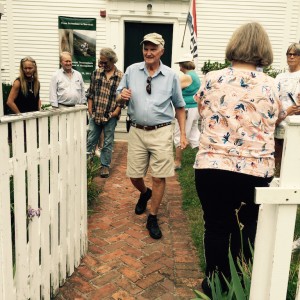Whether you are a day-tripper, summer resident, local, or even a townie listening to Seth Mendell during one of his tours, he will take you back to the time of rich economic expansion in Mattapoisett to meet the people who lived in the antique houses that grace the village streets.
The Mattapoisett Historical Society Museum is once again hosting a series of walking tours around the village guided by Mendell. Although the route may not vary from tour to tour, the content does as Mendell speaks extemporaneously, handing out slices of history from New Bedford to the Caribbean and back again to this little – but historically significant – village.
The first tour of the season took place in advance of the flocks of visitors who came to town for the annual Lions Club Harbor Days event. A group of about 30 walked along Main Street to Water Street, and out onto Long Wharf as Mendell carried them back in time.
Mendell’s knowledge comes from his own investigations, coupled with those of his father, Charles Mendell, who wrote a fairly comprehensive history of whaling in this area back in the 1930s for the Old Dartmouth Historical Society. These men – father and son – have deep roots in the area with the younger Mendell’s local lineage going back on both his maternal and paternal sides. Thus, when you listen to Mendell, you are hearing not only his take on local history, but also the cumulative accounts of many generations.
As the tour wound its way through the village, Mendell told the group that men in the whaling trade also ran taverns and inns to support the many workers and travelers coming into Mattapoisett. Pointing at houses along Main Street from Town Hall to Water Street, Mendell pointed out several that were used as public houses, general stores, and taverns.
Of cabinetmakers, he said that theirs was a very profitable trade because cabinetmakers also built coffins. Those were always in high demand.
Arriving at the Mattapoisett Land Trust parcel known as Munro Preserve, Mendell pointed towards Goodspeed Island and detailed the process by which salt was pulled from the neighboring harbor.
“One barrel of salt was needed for three barrels of fish,” he said, going on to say that the importance of salt trumped the importance of gold during these times.
Before the Revolutionary War, salt had been imported from England, Spain, and France. With the advent of the war, colonists had to find another source; hence, the evaporation process was developed. Mendell said salt cured both meats and fish, making it possible to survive long winters. And without salt, he asked, “What were you going to eat?” The process itself was nothing short of life sustaining, he inferred.
Mendell helped the group imagine a time when, along what is now a barrier beach near the Reservation Golf Club, raised vats stood approximately 12 feet square by 1 foot deep set on posts and fed water by windmills. The sun evaporated the water, leaving behind salt and other minerals. Shed roofs that were slid into place as needed were constructed to protect the drying vats from weather conditions. The whole process took about one month to complete.
Arriving at Long Wharf, Mendell directed the group’s attention landward to Shipyard Park and told them that shipbuilding required long narrows strips of land. This allowed many builders to occupy a fairly small space from Pearl Street to Mechanics Street. Such well-known street names were once the names of the builders themselves, such as Barstow, Holmes, and Cannon.
Joshua Holmes was responsible for building the last whaling ship, The Wanderer, whose massive mainsail is now the flagpole centered in Shipyard Park. And the whaling vessel, The Acushnet, – best known as the ship on which Herman Melville sailed as a young man, whetting his creative imagination and powers of observing human nature and turning it all into the international best seller, Moby Dick – was built right here in Mattapoisett.
The most prominent shipbuilder of his day does not have a street named after him. That man was Joseph Meigs who owned what is now the Inn at Shipyard Park. His is a rags-to-riches story as Miegs went from being a poor Rochester farm boy to a major businessman through sheer force of single-minded determination.
One of the tourists asked if Marion had been part of this boom in the ship building trade. To a much lesser degree, Mendell said, since Marion’s harbor was too shallow for large whaling vessels, coupled with a small island that made navigating into the harbor difficult at best for boats of any size. For this reason, Nantucket also lost its significance, he said, as a shipbuilding port. As the ships became larger for sailing farther and farther out to sea in search of whales, shallow harbors could not support them. New Bedford and Mattapoisett became the prime movers of shipbuilding.
Mendell told the group that these men “were men of the world,” traveling far and wide and bringing back not only exotic goods, but cultural experiences that helped to shape the colonies.
Mendell gives several tours and talks during the summer months, sponsored by the historical museum. For a full schedule of these events and others, go to www.mattapoisetthistoricalsociety.org or stop by the museum where events are posted in an old-fashioned manner: the public bulletin board.
By Marilou Newell
